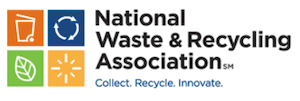NWRA Releases Report on the Impact of Beverage Container Deposit Systems on Materials Recovery Facility Costs and Revenues
Study Concludes Deposit Systems Raise Recycling Rates Overall While Increasing Costs and Reducing Revenues at MRFs
Arlington, VA – The National Waste & Recycling Association (NWRA) has released a study that evaluates the impact of beverage container deposit systems, also known as bottle bills, on materials recovery facility (MRF) costs and revenues and those impacts on municipalities.
The study, prepared by Resource Recycling Systems (RRS), models six deposit scenarios with variations based on beverage type and deposit value to show how costs and revenue impact a typical MRF and its community. Each scenario is based on the operational metrics of an average sized MRF with 93,600 tons per year throughput serving a community of approximately 1.25 million people in 473,000 households.
“There has been a long-running discussion about how bottle bills impact MRF revenues,” said NWRA President and CEO Darrell Smith. “This study applies numbers on those impacts and looks at the implications for communities.”
The study concludes that beverage container deposits raise recycling rates overall while increasing recycling costs and lowering revenues at MRFs. Although deposits do lead to substantially greater recovery overall, they also lead to higher costs and lower revenues at the MRF as high-value materials move to the deposit system and out of the MRF, thereby reducing revenues and making the total throughput smaller. The research estimates that municipalities will see an increase of approximately $2.50 to $5.00 per household per year in MRF costs, depending on the deposit scenario, and provides an overview of policy tools to address those increased costs.
“This study provides useful data demonstrating the impact of beverage container deposit systems on material recovery facilities and shows a need for balance between system and policy,” said Resa Dimino, RRS managing principal. “We need to ensure that municipalities and MRFs are kept whole as higher quality materials are collected and removed from our waste streams and waterways.”
Further study is needed to understand the impacts on recycling collection costs and throughput due to density changes not evaluated in this study.
The report is available for download here.
###
ABOUT NWRA
The National Waste & Recycling Association (NWRA) represents the private sector waste and recycling services industry. Association members conduct business in all 50 states and include companies that manage waste, recycling and medical waste, equipment manufacturers and distributors, and a variety of other service providers. For more information about NWRA, please visit www.wasterecycling.org.
Contact
Brandon Wright
National Waste and Recycling Association
bwright@wasterecycling.org
202-364-3706

